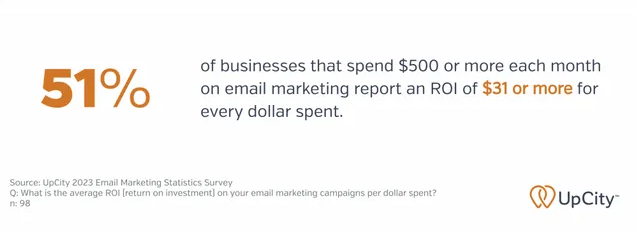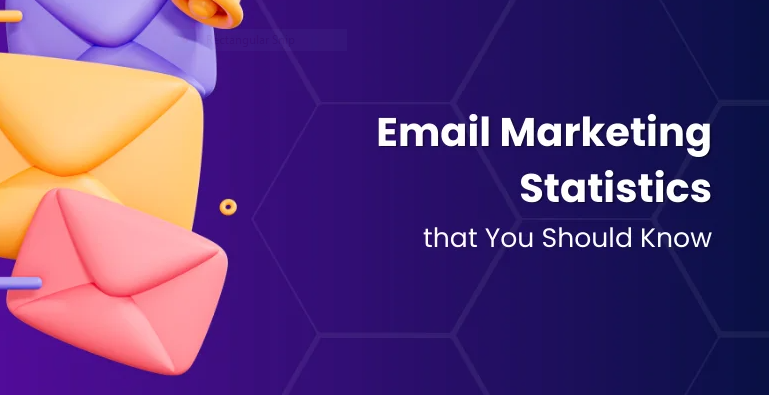Since its birth in 1971, Email has become an inseparable part of marketing strategies for businesses. With over 4.5 billion active users in 2025, email marketing has far more ROI than social media, paid search, and SEO. Further, 95% of marketers say that implementing an email marketing strategy helped them achieve their business goals.
However, to take your email marketing campaigns to the next level, you must stay on top of the latest statistics and trends. In this blog post, we have listed 10 email marketing statistics you need to know in 2025. These stats will help you craft compelling and personalized emails to reach your target audience and boost conversions.
What is Email Marketing? Everything Explained
Email is a strategic digital marketing channel that leverages email to communicate with the target audience. This marketing method helps you build relationships, promote your company’s products, increase brand awareness and customer engagement, and drive conversions. It is a great way to keep your clients up-to-date on your latest offers by sending promotional messages, updates, and personalized content.
Marketers can do email marketing in two ways. First, they can use third-party platforms like Mailchimp, HubSpot, or Sender to send personalized marketing campaigns. The second method involves doing it in-house. Whichever method you choose, it helps you know the benchmarks and results you can anticipate from your email marketing campaigns.
Key components of email marketing involve audience segmentation, personalization, automation, analytics, and optimization. Considering these metrics in crafting a marketing strategy allows for personalization and measurable results, making email marketing an indispensable tool.
10 Key Email Marketing Statistics You Need to Know in 2025
The following are the 10 key email marketing statistics that you must know in 2025 if you are looking to launch personalized email marketing campaigns.
1. Email Marketing Metrics Statistics
It is important to track the progress of your marketing emails; otherwise, you are shooting in the dark. Tracking key email marketing metrics like Click-Through Rate, Open Rate, and Bounce Rate helps you improve the effectiveness of your emails.
Let’s examine the essential email marketing metrics to see how your campaigns compare to industry benchmarks.
Click-Through Rate (CTR)
Click-through rate (CTR) is the percentage of people who click on the link, CTA, or linked image attached to your marketing emails. Tracking this metric helps marketers understand how recipients interact and respond to their emails.
Let’s have a look at some statistics around CTR:
- Autoresponder emails have the highest CTR, ranging from 3.2% – 6.7%.
- On average, email campaigns for all industries see a CTR of 3.25%. For Newsletters, the CTR is 3.84%, while triggered emails receive a CTR of around 5.02% (GetResponse Email Marketing Benchmark Report 2024).
- On the other hand, image-based emails have a click-through rate of 4.84%, Text-based emails get a CTR of 5.02%, while CTAs get a CTR of 3-5%.
- When analyzed countries-wise, Canada had the highest CTR of 7.41% on marketing emails in 2022.
- Marketing emails for real estate, design, and construction have a CTR of 3.6%.
Email Open Rate
Email open rate is the percentage of individuals who received and opened a marketing email from a business. It is an important metric to track as it helps you craft effective email subject lines. You can also optimize the sending time to draw the attention of more customers.
A good email open rate should be between 19% and 26%. Let’s discuss the email open rate across different industries.
· On average, the open rate for email marketing campaigns for all industries jumped from 25.10% in 2023 to 39.64% in 2024.
· The triggered emails have an open rate of 45.38%.
· Newsletters have 40.08%, emails with preheader text have a 44.67% open rate and emails without preheader text have a 39.28% open rate.
· Marketing emails with personalized subject lines have a 44.30% open rate.
· Welcome emails have the highest open rate of 83.63%.
· 57.8% of the marketers reported an open rate of 20-50% in the email marketing campaigns.
Email Conversion Rate
Conversion rate, an ROI measurement metric, refers to the percentage of subscribers who took specific action after reading your marketing email. Marketers can use this metric to evaluate the effectiveness of their marketing campaigns and make necessary changes to achieve their goals.
- Let’s examine the key statistics about the conversion rate.
- Automated welcome emails have a conversion rate of 52%.
- E-commerce automated email had a conversion rate of 3% in 2022.
- On average, the conversion rate for marketing email across all industries is 2.6%.
- Automated emails have a conversion rate of 1.9%.
- Back-in-stock emails have a conversion rate of 5.84%.

Bounce Rate
The bounce rate is the percentage of emails that couldn’t be sent to subscribers. These emails bounced back to the sender. The average bounce rate for marketing emails across all industries is only 2.33%, while the Asia Pacific Region has a bounce rate of 0.58%.
2. B2B Email Marketing Statistics
Email marketing is an excellent tool for B2B businesses to connect to their target audience, nurture relationships, and generate more leads and sales. The 2023 B2B Marketing Survey states that 50% of B2B marketers consider email marketing the most impactful channel in their marketing strategy.
· Similarly, email was the 4th highest-owned media platform for 69% of the B2B marketers in 2023 to share content.
· 71% of the B2B business owners leverage an email newsletter in their content marketing strategy.
· B2B marketing email have a 15.14% open rate and 3.18% CTR.
· 42% of the B2B marketers consider email the most powerful marketing channel.
3. B2C Email Marketing Statistics
Email marketing is also essential for B2C businesses as it can turn window shoppers into permanent clients. This improves customer loyalty, boosts engagement, and increases retention rate.
Let’s prove the importance of email marketing with some statistics:
· Marketing emails influence the purchasing decisions of 59% of customers, with 50% of customers at least purchasing once a month from an email.
· 61% of B2C businesses used emails to distribute content in 2023. Similarly, 65% of B2C marketers use it to manage content, while 6*% of B2C businesses use email newsletters.
· 80% of small and midsized B2C businesses claim that email marketing is the most powerful tool for retaining customers.
· Further, abandoned cart email marketing strategies have an open rate of 50.50%.
· 63% of B2C businesses leverage automated emails to promote their products.
4. Mobile Email Marketing Statistics
Due to their profitability, mobile devices claim over half of all web traffic. The following stats show the importance of email marketing, which helps businesses stay ahead of the curve.
· Nearly half of global internet users prefer email to receive business communications.
· In July 2023, 56% of email marketers decided to optimize email designs for mobile phones.
· During holidays, the email open rate is higher than during the rest of the year.
5. Email Marketing ROI
Email ROI helps measure the profitability of your email marketing campaigns. You can calculate the revenue generated through your email versus the total spend. The following stats show the importance of email marketing ROI.
· Overall ROI of email marketing is 4200%.
· You can expect an ROI of nearly 40$ for every dollar you spend on email marketing.
· About 52% of email marketers reported a 2% increase in ROI via their marketing campaigns.
· Measuring ROI is the most effective way for 38 marketers to measure the performance of your email programs.

6. Email Engagement Statistics
Marketers always expect their clients to engage with their email and its content. However, achieving high engagement rates depends on several factors, including sender reputation and email deliverability. One crucial step to improve these factors is email warm-up, which gradually builds a positive sender reputation by sending emails in a controlled manner before launching full-scale campaigns. A well-executed warm-up process increases the chances of emails landing in the inbox instead of the spam folder, improving engagement rates.
Let’s see how many percent of people show engagement with the received emails:
- Studies show 36.5% is the average engagement rate or open rate across all industries.
- Retail businesses show an average email engagement rate of 33.1%.
- Email marketing campaigns have the highest open rates.
- Nearly 62% of the US B2B and B2C businesses have allocated more budgets to increase engagement.
By implementing an email warm-up strategy, businesses can enhance deliverability, improve engagement rates, and maximize the impact of their email marketing efforts.
7. Email Marketing Demographics
Understanding your target audience’s demographics is essential to crafting compelling business emails. Email marketing demographics studies show that around 6 out of 10 US Millennials have used email for online shopping.
- Stats show that 58% of email users open their inbox as soon as they receive an email.
- 10 seconds is the average spending time of consumers on brand-related emails.
Consider the following stats regarding age groups only in the US.
- Email users aged between 25-44 years are 95%.
- 15-24 years old email users are 93.4%.
- Among 65+ years old people, 85.5% use email.
8. Email Segmentation and Personalization
Personalizing emails is essential in converting more leads, especially emails based on user intent which are more effective because they resonate with the recipient’s needs at the right time. This is where behavioral email marketing shines—by analyzing user actions, preferences, and engagement patterns, businesses can send highly relevant emails that drive better conversions
- 80% of email marketers report that personalization, like dynamic message personalization, subject line personalization, and content personalization, improves performance.
- Similarly, 68% of marketers say that dynamic content personalization in emails improves your success.
- 71% of customers expect brands to offer personalized messages about discounts or offers.
- 78% of marketers leverage personalized communication to craft compelling emails and attract customers.
- In addition, 90% of email marketing professionals state that subscriber segmentation improves your marketing emails’ success.
9. AI Email Marketing Statistics
Artificial intelligence is advancing email marketing by providing data analyzing tools for personalization and automation. AI also offers marketers a hand in content creation.
Let’s examine the impact of AI in email marketing:
- 87% of adopters use AI to improve email marketing campaigns.
- 49% of email marketers leverage AI for content.
- 41% of marketers reported 13% more CTR and increased revenue with AI-created marketing campaigns.
10. Email Marketing Automation
Automated email campaigns have an average open rate of 42.1% and a CTR of 5.4%.
- 58% of businesses use email automation to improve their campaigns.
- 1 out of 3 people who receive automated emails purchase it.
- Similarly, 48% of marketers use email automation in their marketing campaigns.
Final Words
Email marketing is of prime importance in marketing campaigns for any business. The email marketing statistics discussed above show that sending email warmups to your subscribers will increase engagement, ROI, leads, and, ultimately, sales.
Understanding these email marketing stats helps you craft compelling content according to your subscriber’s needs and preferences and build brand awareness.

Andrej Fedek is the creator and the one-person owner of two blogs: InterCool Studio and CareersMomentum. As an experienced marketer, he is driven by turning leads into customers with White Hat SEO techniques. Besides being a boss, he is a real team player with a great sense of equality.
